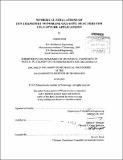| dc.description.abstract | Numerical simulations were performed to investigate the key features of oxygen permeation and hydrocarbon conversion in ion transport membrane (ITM) reactors. ITM reactors have been suggested as a novel technology to enable air separation and fuel conversion to take place simultaneously in a single unit. Possessing the mixed ionic and electronic conductivity, perovskite membranes or ion transport membranes permeate selectively oxygen ions from the air (feed) side to the sweep gas or reactive gas (permeate) side of the membrane, driven by the oxygen chemical potential gradient across the membrane at elevated temperature. When a fuel such as methane is introduced into the permeate side as a sweep gas, hydrocarbon oxidation reactions occur by reacting the fuel with the permeated oxygen. The fuel can be partially reformed, completely oxidized or converted to produce higher hydrocarbons. To utilize this technology more effectively, it is necessary to develop a better understanding of oxygen transport and hydrocarbon conversion in the immediate vicinity of the membrane or on its surface. In this thesis, a planar, finite-gap stagnation flow configuration was used to model and examine these processes. A spatially resolved physical model was formulated and used to parameterize an oxygen permeation flux expression in terms of the oxygen concentrations at the membrane surface given data on the bulk concentration. The parameterization of the permeation flux expression is necessary for cases when mass transfer limitations on the permeate side are important and for reactive flow modeling. At the conditions relevant for ITM reactor operation, the local thermodynamic state should be taken into account when the oxygen permeation rate is examined, which has been neglected. To elucidate this, the dependency of oxygen transport and fuel conversion on the geometry and flow parameters including the membrane temperature, air and sweep gas flow rates, oxygen concentration in the feed air and fuel concentration in the sweep gas was discussed. The reaction environment on the sweep side of an ITM was characterized. The spatially resolved physical model was used to predict homogeneous-phase fuel conversion processes and to capture the important features (e.g., the location, temperature, thickness and structure of a flame) of laminar oxy-fuel diffusion flames stabilized on the sweep side. The nature of oxygen permeation does not enable pre-mixing of fuel and oxidizer (i.e., sweep gas and permeated oxygen), establishing non-premixed flames. In oxy-fuel combustion applications, the sweep side is fuel-diluted with CO₂ or/and H₂O, and the entire unit is preheated to achieve a high oxygen permeation flux. This study focused on the flame structure under these conditions and specifically on the chemical effect of CO₂ dilution. The interactions between oxygen permeation and homogeneous-phase fuel oxidation reactions on the sweep side of an ITM were examined. Within ITM reactors, the oxidizer flow rate, i.e., the oxygen permeation flux, is not a pre-determined quantity, since it depends on the oxygen partial pressures on the air and sweep sides and the membrane temperature. Instead, it is influenced by the hydrocarbon oxidation reactions that are also dependent on the oxygen permeation rate, the initial conditions of the sweep gas, i.e., the fuel concentration, flow rate and temperature, and the diluent. A parametric study with respect to key operating conditions, which include the fuel concentration in the sweep gas, its flow rate and temperature and the geometry, was conducted to investigate their interactions. The catalytic kinetics of heterogeneous oxygen surface exchange and fuel oxidation for a perovskite membrane in terms of the thermodynamic state in the immediate vicinity of or on the membrane surface was investigated. Perovskite membranes have been shown to exhibit both oxygen perm-selectivity and catalytic activity for hydrocarbon conversion. However, a description of their catalytic surface reactions is still required. The kinetic parameters for heterogeneous oxygen surface exchange and catalytic fuel conversion reactions were inferred, based on permeation rate measurements and a spatially resolved physical model that incorporates detailed chemical kinetics and transport in the gas-phase. It is shown that the local thermodynamic state at the membrane surface should be accounted for when constructing and examining membrane permeation and heterogeneous chemistry. The significance of modeling both homogeneous and heterogeneous chemistry and their coupling when examining the results was discussed. | en_US |
